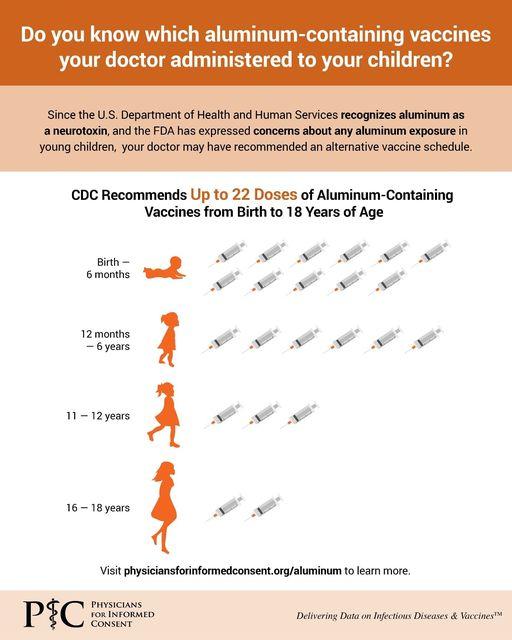Are ANY Vaccines Safe And Effective Any More?

What’s so bad about vaccines?
Vaccines contain things that are harmful to our health or that are poorly tested for safety:
- Vaccines contain dangerous additives (called adjuvants).
- Vaccines contain mRNA materials with unknown long term side effects.
- Vaccines contain additives like mercury compounds and aluminum compounds that can have negative effects on the human brain.
- Vaccines contain aborted fetal tissue which many people are unaware of and who would never want to be injected with tissue extracted from aborted babies.
- Limited and fraudulent testing is performed on vaccines. Typically, people who drop out of a vaccine safety trial in the first 30 days (drop out due to side-effects primarily) are NOT COUNTED in the vaccine safety results.
- Vaccine manufacturers are protected from lawsuits by government regulations that limit the drug company liability related to patient injury and death caused by their deadly drugs and vaccines.
- Vaccines are much less effective overall, than natural immunity, and natural immunity is better, safer and lasts longer.
- Very safe and effective preventions and treatments for diseases are available, natural treatments that have zero risk (or close to zero risk) of side effects.
There is a wide range of vaccines – some requiring multiple doses at specific ages and times – that are recommended from birth to 18 years old. Some require multiple shots/doses totally around 36 shots by the age of 18. Infants are given their first vaccination just TWELVE HOURS AFTER BIRTH. It is for Hepatitis B.
Government recommended (CDC recommended) vaccines for children include:
- Influenza (annual flu shot)
- Diphtheria, tetanus and pertussis (DTaP)
- Tetanus, diphtheria and acellular pertussis (Tdap “booster” for adolescents)
- Poliovirus (IPV)
- Measles, mumps and rubella (MMR)
- Varicella (Chickenpox)
- Pneumococcal (PCV)
- Haemophilus influenzae type b (Hib)
- Rotavirus
- Hepatitis B (Hep B)
- Hepatitis A (Hep A)
- Human papillomavirus (HPV)
- Meningococcal (MenACWY)
- Meningococcal B (MenB)**
The health of dogs & cats is more important than the health of humans:
I have noticed that there are hardly ANY articles on the internet that speak of the dangerous additives in vaccines for humans. It is easier to find articles describing that dangers of these same additives in vaccines for dogs. Here are two such articles with excerpts from each:
1. Harmful Dog Vaccine Ingredients – What You Need To Know
Excerpt: “Adjuvants (vaccine additives): aluminum salts, oil-based squalene, bacteria-based lipopolysaccharides, sugars. Preservatives: mercury ( thimerosal), antibiotics (gentamicin, amphotericin B, neomycin, polymyxin-B), phenoxyethanol. Attenuating agents: formaldehyde. Growth medium: foreign animal tissues: Chick embryo, Bovine serum, Human fetal lung tissue, Monkey kidney tissue, insect proteins,” [and the list goes on…]
2. Why Vaccine Detox For Dogs Is Important
Excerpt: “Aluminum is the most common adjuvant in veterinary vaccines. Adjuvant means it exaggerates an immune response. And aluminum targets the brain and endocrine (hormonal) system. This can cause brain and nervous system degeneration, vaccine-associated cancers, seizures and behavior issues.”
3. Check out this vaccine insanity… a quote from section #5 of the below linked article:
“In cats, the Feline Vaccine Associated Sarcoma is an aggressive malignant tumor that appears at vaccine injection sites. What is the veterinary solution for this? To vaccinate cats in the tail so it can easily be removed when fibrosarcoma strikes.” Source: https://www.dogsnaturallymagazine.com/prevent-cancer-dogs/
Additional Information About Vaccines And Vaccine Dangers:
- Moderna Halts mRNA RSV Vaccine Trial for Children After Five Infants were Hospitalized
- Vaxxed v. Unvaxxed – Weaponization of injectables
- Are You Ready To Meet the Babies In Your Next Vaccines?
- The Real Risks of Childhood Vaccines
- DEATH BY VAXX: Excess Mortality up 17% Among the Fully Vaccinated
- Steve Kirsch During PA State Senate Hearing : “We Can’t Find an Autistic Kid Who Was Unvaccinated” Within Amish Community (VIDEO)
- Unvaxxed Amish Death Rates 90 Times Lower Than Rest of America
- WHO recommends groundbreaking malaria vaccine for children (Big Pharma pushing more jabs on kids)
- RFK Jr. Explains How Relentless Moms Got Him to Fight Dangerous Child Vaccines
- Scientists say fetal tissue remains essential for vaccines and developing treatments
- Morally Tainted: Products Made Possible by the Killing of Innocent Human Life
- Development Of Vaccines From Aborted Babies
- The CDC Makes Money On Vaccines
- Aborted Fetal Cell Line Vaccine Products And Ethical Alternatives
REFERENCES:
1. Child immunization schedule: The full list of vaccines for children by age, according to CDC guidelines
2. Recommended Vaccinations for Infants and Children (from CDC website)
3. Fetal Tissue Used In Vaccines